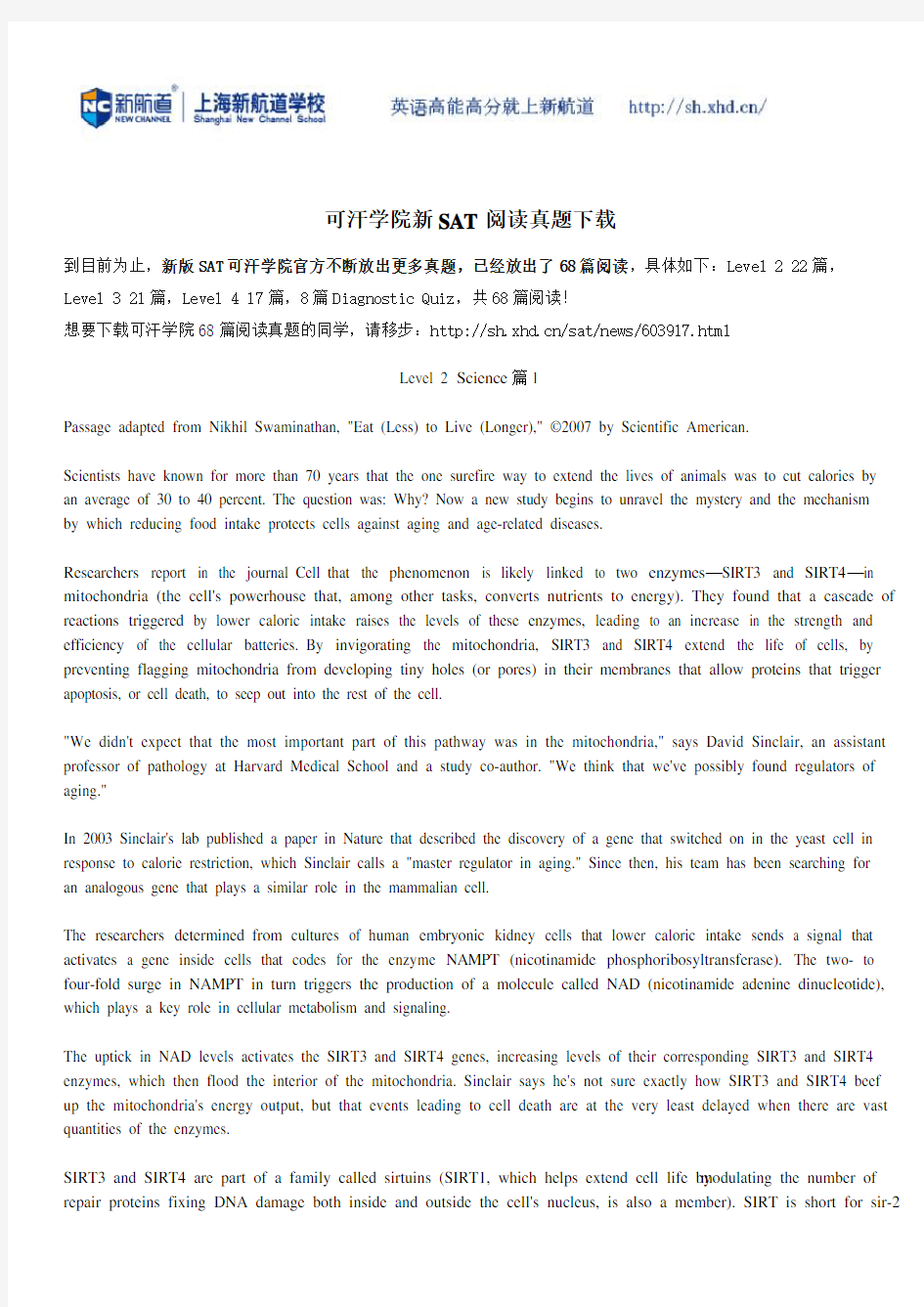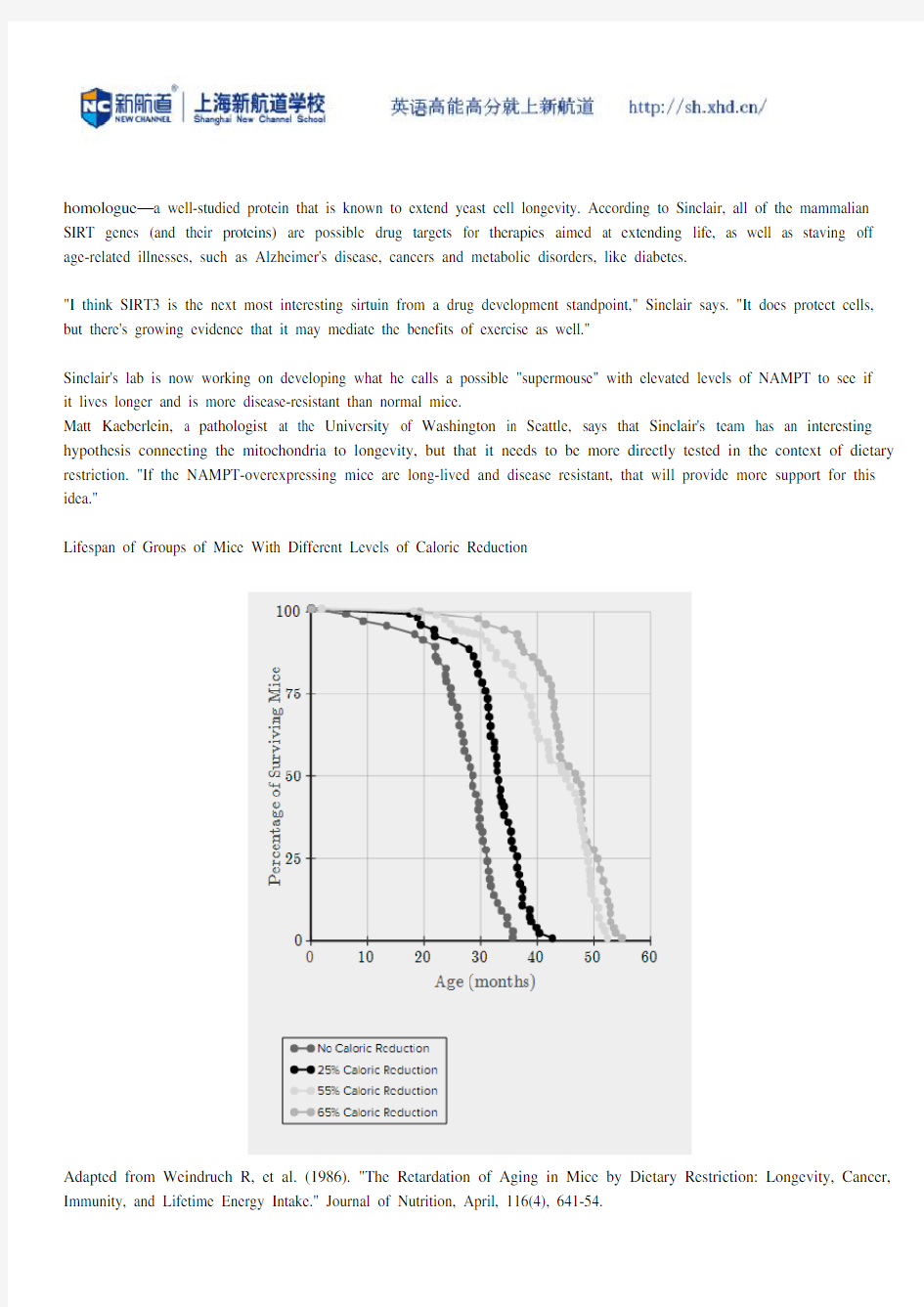可汗学院新SAT阅读真题下载(68篇)


可汗学院新SAT阅读真题下载
到目前为止,新版SAT可汗学院官方不断放出更多真题,已经放出了68篇阅读,具体如下:Level 2 22篇,Level 3 21篇,Level 4 17篇,8篇Diagnostic Quiz,共68篇阅读!
想要下载可汗学院68篇阅读真题的同学,请移步:https://www.360docs.net/doc/6f8425927.html,/sat/news/603917.html
Level 2Science篇1
Passage adapted from Nikhil Swaminathan, "Eat (Less) to Live (Longer)," ?2007 by Scientific American.
Scientists have known for more than 70 years that the one surefire way to extend the lives of animals was to cut calories by an average of 30 to 40 percent. The question was: Why? Now a new study begins to unravel the mystery and the mechanism by which reducing food intake protects cells against aging and age-related diseases.
Researchers report in the journal Cell that the phenomenon is likely linked to two enzymes—SIRT3 and SIRT4—in mitochondria (the cell's powerhouse that, among other tasks, converts nutrients to energy). They found that a cascade of reactions triggered by lower caloric intake raises the levels of these enzymes, leading to an increase in the strength and efficiency of the cellular batteries. By invigorating the mitochondria, SIRT3 and SIRT4 extend the life of cells, by preventing flagging mitochondria from developing tiny holes (or pores) in their membranes that allow proteins that trigger apoptosis, or cell death, to seep out into the rest of the cell.
"We didn't expect that the most important part of this pathway was in the mitochondria," says David Sinclair, an assistant professor of pathology at Harvard Medical School and a study co-author. "We think that we've possibly found regulators of aging."
In 2003 Sinclair's lab published a paper in Nature that described the discovery of a gene that switched on in the yeast cell in response to calorie restriction, which Sinclair calls a "master regulator in aging." Since then, his team has been searching for an analogous gene that plays a similar role in the mammalian cell.
The researchers determined from cultures of human embryonic kidney cells that lower caloric intake sends a signal that activates a gene inside cells that codes for the enzyme NAMPT (nicotinamide phosphoribosyltransferase). The two- to four-fold surge in NAMPT in turn triggers the production of a molecule called NAD (nicotinamide adenine dinucleotide), which plays a key role in cellular metabolism and signaling.
The uptick in NAD levels activates the SIRT3 and SIRT4 genes, increasing levels of their corresponding SIRT3 and SIRT4 enzymes, which then flood the interior of the mitochondria. Sinclair says he's not sure exactly how SIRT3 and SIRT4 beef up the mitochondria's energy output, but that events leading to cell death are at the very least delayed when there are vast quantities of the enzymes.
SIRT3 and SIRT4 are part of a family called sirtuins (SIRT1, which helps extend cell life by modulating the number of repair proteins fixing DNA damage both inside and outside the cell's nucleus, is also a member). SIRT is short for sir-2
homologue—a well-studied protein that is known to extend yeast cell longevity. According to Sinclair, all of the mammalian SIRT genes (and their proteins) are possible drug targets for therapies aimed at extending life, as well as staving off age-related illnesses, such as Alzheimer's disease, cancers and metabolic disorders, like diabetes.
"I think SIRT3 is the next most interesting sirtuin from a drug development standpoint," Sinclair says. "It does protect cells, but there's growing evidence that it may mediate the benefits of exercise as well."
Sinclair's lab is now working on developing what he calls a possible "supermouse" with elevated levels of NAMPT to see if it lives longer and is more disease-resistant than normal mice.
Matt Kaeberlein, a pathologist at the University of Washington in Seattle, says that Sinclair's team has an interesting hypothesis connecting the mitochondria to longevity, but that it needs to be more directly tested in the context of dietary restriction. "If the NAMPT-overexpressing mice are long-lived and disease resistant, that will provide more support for this idea."
Lifespan of Groups of Mice With Different Levels of Caloric Reduction
Adapted from Weindruch R, et al. (1986). "The Retardation of Aging in Mice by Dietary Restriction: Longevity, Cancer, Immunity, and Lifetime Energy Intake." Journal of Nutrition, April, 116(4), 641-54.
QUESTION 1 OF 11
The author indicates that caloric reduction extends the life of a mammalian cell by
1
1 The author indicates that caloric reduction extends the life of a mammalian cell by
A) turning off those genes involved in apoptosis, or cell death.
B) forcing the mitochondria to utilize different energy sources for fuel.
C) reducing the production of NAD (nicotinamide adenine dinucleotide).
D) initiating a series of steps that results in the increased production of certain enzymes.
2 Based on the passage, SIRT-
3 and SIRT-
4 indirectly affect cell longevity by
A) strengthening the mitochondrial membrane.
B) fixing damage to the cell’s DNA.
C) initiating cell death.
D) diminishing the efficiency of the cell’s mitochondria.
3 Which choice provides the best evidence for the answer to the previous question?
A) lines 7-9 (“Researchers ... mitochondria”)
B) lines 13-18 (“By ... cell.”)
C) lines 38-41 (“The ... mitochondria”)
D) lines 41-44 (“Sinclair ... enzymes”)
9
4 The author’s use of the words “powerhouse” and “batteries” in the second paragraph serves mainly to
A) emphasize that mitochondria are the most important components of the cell.
B) suggest that mitochondria use an electrical gradient to produce energy
C) stress that mitochondria are the main sources of energy for the cell.
D) imply that mitochondria need to be recharged in order to function efficiently
5 As used in line 15 (“flagging”), “flagging” most nearly means
A) breaking.
B) shrinking.
C) folding.
D) weakening.
6 The main purpose of the fifth paragraph (lines 30-37) is to
A) suggest that caloric reduction has a different effect on yeast cells than mammalian cells.
B) highlight the important role that the kidney plays in the aging process.
C) clarify the intermediate steps between caloric reduction and improved mitochondrial efficiency.
D) identify the negative relationship between NAMPT production and NAD production.
7 The author implies that the results of Sinclair’s study will enable future scientists to
A) reverse the aging process.
B) diagnose patients with age-related illnesses from an earlier age.
C) create mice that are essentially immortal.
D) more effectively treat a number of age-related illnesses.
8 Which choice provides the best evidence for the answer to the previous question?
A) lines 45-50 (“SIRT ... longevity.”)
B) lines 50-54 (“According ... diabetes.”)
C) lines 59-62 (“Sinclair’s ... mice”)
D) lines 67-69 (“If ... idea”)
9 The main purpose of the graph is to
A) illustrate the relationship between caloric intake and longevity in different groups of mice.
B) highlight how caloric reduction affects SIRT-3 enzyme production in different groups of mice.
C) suggest that caloric reduction affects mice differently than it affects yeast.
D) indicate that it is likely impossible to produce a genetically enhanced “supermouse.”
10 How does the information in the graph relate to the author’s claim that caloric reduction increases the longevity of mammalian cells?
A) It supports the claim, but suggests that the differences in longevity are marginal after a 25% caloric reduction.
B) It supports the claim since the average lifespan of each group of mice increases as caloric reduction increases.
C) It does not support the claim since the group of mice that did not have any caloric reduction had the highest survival rate after 35 months.
D) It does not support the claim since all four groups of mice had the same average lifespan.
11 It can reasonably be inferred from the graph that, 30 months into the study,
A) all of the mice in the “55% caloric reduction”group were still alive.
B) all of the mice in the “25% caloric reduction”group were still alive.
C) approximately 50% of the mice in the “no caloric reduction” group we re still alive.
D) none of the mice in the “no caloric reduction” group were still alive.
